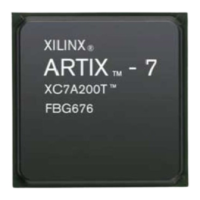MicroBlaze Processor Reference Guide 54
UG984 (v2018.2) June 21, 2018 www.xilinx.com
Chapter 2: MicroBlaze Architecture
Avoiding Data Hazards
In some cases, the MicroBlaze GNU Compiler is not able to optimize code to completely
avoid data hazards. However, it is often possible to change the source code in order to
achieve this, mainly by better utilization of the general purpose registers.
Two C code examples are shown here:
• Multiplication of a static array in memory
static int a[4], b[4], c[4];
register int a0, a1, a2, a3, b0, b1, b2, b3, c0, c1, c2, c3;
a0 = a[0]; a1 = a[1]; a2 = a[2]; a3 = a[3];
b0 = b[0]; b1 = b[1]; b2 = b[2]; b3 = b[3];
c0 = a0 * b0; c1 = a1 * b1; c2 = a2 * b2; c3 = a3 * b3;
c[3] = c3; c2 = c[2]; c1 = c[1]; c0 = c[0];
This code ensures that load instructions are first executed to load operands into
separate registers, which are then multiplied and finally stored. The code can be
extended up to 8 multiplications without running out of general purpose registers.
• Fetching a data packet from an AXI4-Stream interface.
#include <mb_interface.h>
static int a[4];
register int a0, a1, a2, a3;
getfsl(a0, rfsl0); getfsl(a1, rfsl0); getfsl(a2, rfsl0); getfsl(a3, rfsl0);
a[3] = a3; a[1] = a1; a[2] = a2; a[0] = a0;
This code ensures that get instructions using different registers are first executed, and
then data is stored. The code can be extended to up to 16 accesses without running out
of general purpose registers.
